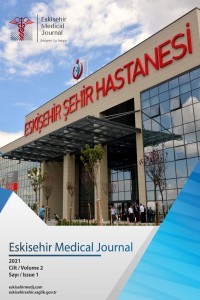Şiddetli Nekrotizan Fasiit: Olgu Sunumu
nekrotizan fasiit, yumuşak doku nekrozu, yumuşak doku enfeksiyonu
Severe Necrotizing Fasciitis: Case Report
___
- Referans1. Yagmur O, Erkocak EU, Sonmez H Alparslan A, Demircan O,Dalay C. Necrotizing fasciitis. Dig Surg 1995;12:106-10.ALTINTOP ve ark.Nekrotizan Fasiit Olgu Bozok Tıp Derg 2016;6(4):68-71 Bozok Med J 2016;6(4):68-71.
- Referans2.Napolitano LM. Severe soft tissue infections. Infect Dis Clin North Am 2009; 23: 571-591.
- Referans3. Fichev G, Kostov V, Marina M ve ark. Fornier’s gangrene: a clinical and bacteriological study. Anaerobe 1997;3:195-7.
- Referans4. Swartz MN, Pasternack MS. Cellulitis, necrotizing fasciitis, and subcutaneous tissue infections. In: Mandell GL, Bennett JE, Dolin R (Eds). Principles and practice of infectious diseases. 7th ed. New York: Churchill Livingstone; 2010: p. 1289-1312.
- Referans5. Liu YM, Chi CY, Ho MW ve ark. Microbiology and factors affecting mortality in necrotizing fasciitis. J Microbiol Immunol Infect 2005;38: 430-435.
- Referans6. Trent JT, Kirsner RS. Diagnosing necrotizing fasciitis. Adv Skin Wound Care 2002;15:135-8.
- Referans7. File TM Jr, Tan JS, DiPersio JR. Group A streptococcal necrotizing fasciitis. Diagnosing and treating the “flesh-eating bacteria syndrome”. Cleve Clin J Med 1998;65:241-9.
- Referans8. Kuncir EJ, Tillou A, Hill CR ve ark. Necrotizing soft tissue infections, Emerg Med Clin North Am 2003;21:1075-87.
- Referans9. Addison WA, Livengood CH 3rd, Hill GB ve ark. Necrotizing fasciitis of vulvar origin in diabetic patients. Obstet Gynecol 1984;63:473-9.
- Referans10. Kaul R, McGeer A, Low DE ve ark. Population-based surveillance for group A streptococcal necrotizing fasciitis: clinical features, prognostic indicators, and microbiologic analysis of seventy-seven cases.Ontario Group A Streptococcal Study. Am J Med 1997;103:18-24.
- Referans11. Levine EG, Manders SM. Life-threatening necrotizing fasciitis.Clin Dermatol 2005;23:144-7.
- Referans12. Ripley DL. Necrotizing fasciitis. Prim Care Update Ob Gyns 2001; 7:142-147.
- Referans13. Lichtenstein D, Stavorovsky M, Irge D. Fournier’s gangrene complicating perianal abscess: report of two cases. Dis Colon Rectum 1978; 21: 377-379.
- Referans14. Carter PS, Banwell PE. Necrotizing fasciitis: a new management algorithm based on clinical classification. Int Wound J 2004;1:189-98.
- Referans15.Levine EG, Manders SM. Life-threatening necrotizing fasciitis. Clin Dermatol 2005;23:144-7.
- Referans16.Wong CH, Khin LW, Heng KS ve ark. The LRINEC (Laboratory Risk Indicator for Necrotizing Fasciitis) score a tool for distinguishing necrotizing fasciitis from other soft tissue infections. Crit Care Med 2004;32:1535-41.
- Referans17. Mulla ZD. Treatment options in the management of necrotizing fasciitis caused by Group A Streptococcus. Expert Opin Pharmacother 2004;5:1695-700.
- Referans18. Taviloglu K, Yanar H. Necrotizing fasciitis: strategies for diagnosis and management. World J Emerg Surg 2007;2:19.
- Referans19. Dufel S, Martino M. Simple cellulitis or a more serious infection? J Fam Pract 2006;55:396-400.
- Referans20. Sudarsky LA, Laschinger JC, Coppa GF ve ark. Improved results from a standardized approach in treating patients with necrotizing fasciitis. Ann Surg 1987;206:661-5.
- Referans21.Cox NH. Streptococcal necrotizing fasciitis and the dermatologist. Br J Dermatol 1999;141:613-4.
- Referans22. Young MH, Aronoff DM, Engleberg NC. Necrotizing fasciitis: pathogenesis and treatment. Expert Rev Anti Infect Ther 2005;3:279-94.
- Referans23.Wang YS, Wong CH, Tay YK. Staging of necrotizing fasciitis based on the evolving cutaneous features. Int J Dermatol 2007;46:1036-41.
- Referans24.Wong CH, Wang YS. The diagnosis of necrotizing fasciitis. Curr Opin Infect Dis 2005;18:101-6.
- Referans25. Oelbrandt B, Krasznai A, Bruyns T, Duinslaeger L, Reper P, Vanderkelen A, et al. Surgical treatment of Fournier’s gangrene: use of cultured allogeneic keratinocytes. Eur J Plast Surg 2000;23:369-372.
- Referans26. Bellapianta JM, Ljungquist K, Tobin E, Uhl R. Necrotizing fasciitis. J Am Acad Orthop Surg 2009;17:174-82.
- Referans27.Wysoki MG, Santora TA, Shah RM, Friedman AC. Necrotizing fasciitis: CT characteristics. Radiology 1997;203:859-63.
- Referans28.Young MH, Aronoff DM, Engleberg NC. Necrotizing fasciitis: pathogenesis and treatment. Expert Rev Anti Infect Ther 2005;3:279-94.
- Referans29.Unalp HR, Kamer E, Derici H, Atahan K, Balci U, Demirdoven C, et al. Fournier’s gangrene: evaluation of 68 patients and analysis of prognostic variables. J Postgrad Med 2008;54:102-5. Nekrotizan fasiit Cilt - Vol. 18 Sayı - No. 6 513.
- Referans30. Anaya DA, Dellinger EP. Necrotizing soft-tissue infection: diagnosis and management. Clin Infect Dis 2007;44:705-10.
- Referans31. Saxena V, Hwang CW, Huang S ve ark. Vacuum-assisted closure: microdeformations of wounds and cell proliferation. Plast Reconstr Surg 2004; 114: 1086-1096.
- ISSN: 2718-0948
- Yayın Aralığı: Yılda 3 Sayı
- Başlangıç: 2020
- Yayıncı: Eskişehir Şehir Hastanesi
Adrenokortikal Karsinom, Tek Merkez 5 Yıllık Deneyim
Hayrettin DİZEN, Dursun Burak ÖZDEMİR, Ahmet KARAYİĞİT, Bülent ÜNAL
Kübital Tünel Sendromuna Neden Olan Ulnar Schwannom: Olgu Sunumu
Turan KANDEMİR, Zeki Serdar ATAİZİ, Müge SEZER
Osman PİRHAN, Sinan AŞAR, Bahar PEHLİVAN, Önder KAYA, İbrahim Faruk AKTÜRK, Fethi KILIÇASLAN, Ercan AKŞİT
COVID-19 Hastalarının Klinik ve Radyolojik Özellikleri: Eskişehir’de Tek Merkez Deneyimi
Pamir ÇERÇİ, Murat BAYAV, Muhittin AKARSU, Hakan AKGÜN, Arzu YURDASİPER, Kamil ÖZDEMİR, Bengü DOĞAN, İlknur AKÇAYIR, Fazilet YALÇIN, Zeynep IRMAK KAYA, Ebru ÖZDEN YILMAZ, Anıl UÇAN, Ayşe KUŞÇU, Nargüler AKSU, Yıldız AKBAY, Ahmet GÜNDÜZÖZ, Yonca YILMAZ ÜRÜN, Berrin YALINBAŞ, Serdar EFE, Fatih AYYILDI
Dilek TOP KARTİ, Neslihan EŞKUT, Özge YILMAZ KÜSBECİ
Ali ÇONER, Emre ERTURK, Salih KILIÇ, Uğur TÜRK
İbrahim Çağrı KAYA, Merih ÖZBAYBURT, Mehmet ÖZGEYİK
Bir Eğitim Programının Menopoz Bilgi Düzeyine Etkisi
Yeliz KAYA, Dilek ŞAYIK, Muzaffer BİLGİN
Filiz KAYA, Şeyhmus KAYA, Engin ÖZAKIN, Ahmet Tuğrul ZEYTİN
Ağır Astımda Serum Periostin ve IL-13 Düzeylerinin Kan Eozinofilisini Belirlemedeki Etkinlikleri
